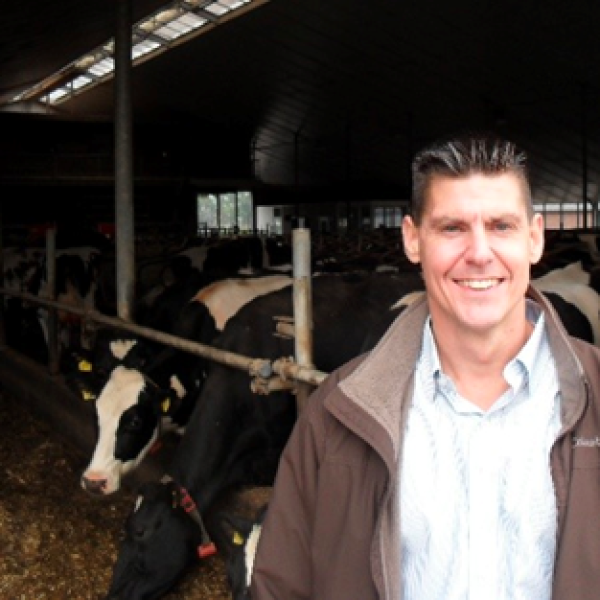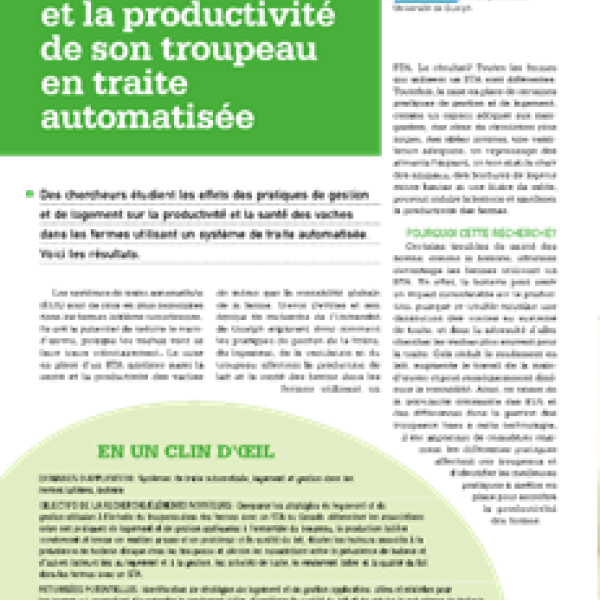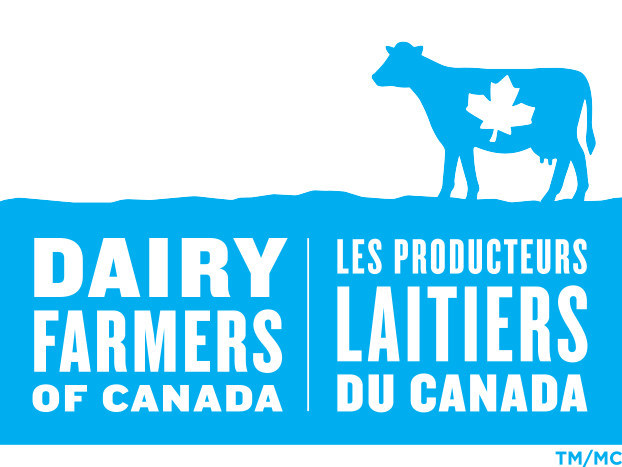Optimizing Health and Production of Cows Milked in Robotic Systems
Complete

Project Overview
The number of dairy farms with robots has quadrupled over the past 5 years in Canada, and adoption of these technologies is continuing to increase. Despite the potential benefits of robotic milking for production labour and cow health, variation in many management and housing factors may impact the overall success of these systems. Furthermore, given the high cost of investment in robotic milking, new ways to continue to improve cow health, milk production, and efficiency are required in order to justify continued adoption of robots in the future. Therefore, the objective of this research was to improve cow health, production, and efficiency of robot use by determining optimal nutritional and housing strategies for cows milked with robots.
What Did the Research Team Do?
A study was conducted with 197 robotic milking dairy farms from across Canada. Each farm was visited to collect information on farm management, feeding practices, and barn design. Feed samples and robot milking data were also collected from each farm. Body condition scoring and lameness were assessed in a subset of farms. Data were analyzed to identify cow and herd level factors influencing milk production and composition, cow health, and efficiency of robot use, including housing (cow traffic system), management, and nutritional factors (concentrate allowance, partial mixed ration composition).
What Did the Research Team Find?
- Each additional 5 feed push-ups per day was an associated 0.35 kg/d greater milk yield.
- Each 10 cm increase in feed bunk space per cow was associated with +0.3 kg/d greater milk production.
- Use of sand bedding was associated with +1.5 kg/d in milk yield compared with those farms using organic bedding types.
- All ventilation methods that included some mechanization were associated with greater milk yield when compared with natural ventilation alone.
- Greater milking frequency was associated with fewer cows per robot, greater alley cleaning frequency per day, and a free traffic access to the robot.
- Maintaining mobility and proper body condition of cows are important to optimize production and milk quality.
- Across farms, nutritional and farm management factors, including dietary crude fat, forage percentage of the diet, dietary energy density, cow traffic flow, and major forage fed on the farm, were associated with greater milking frequency and milk production.
**Scroll down for project communication outputs**
Principal Investigators
Trevor DeVries
University of Guelph
Co-Investigators
Greg Penner
University of Saskatchewan
Karin Orsel
University of Calgary
Key Words
- Robotic milking systems, production, cow health
Period: 2018-2023
Budget: $300,000
Last Updated: January 12, 2024
Note: As per the research agreement, aside from providing financial support, the funders have no decision-making role in the conduct of the studies, data collection, and analysis or interpretation of the data. Researchers are independent in conducting their studies, own their data, and report the outcomes regardless of the results. The decision to publish the results rests entirely with the researchers.
PROJECT COMMUNICATION OUTPUTS

PODCAST
LISTEN
TRADE ARTICLE
DOWNLOADWEBINAR
Optimizing Health and Production on Robotic Dairies

PROJECT PUBLICATIONS
-
Castro, M. M. D., R. D. Matson, D. E. Santschi, M. I. Marcondes, and T. J. DeVries. 2022. Association of housing and management practices with milk yield, milk composition, and fatty acid profile, predicted using Fourier-transform mid- infrared spectroscopy, in farms with automated milking. J. Dairy Sci. 105:1-12. https://doi.org/10.3168/jds.2021-21150
-
Matson, R. D., M. T. M. King, T. F. Duffield, D. E. Santschi, K. Orsel, E. A. Pajor, G. B. Penner, T. Mutsvangwa, and T. J. DeVries. 2022. Farm-level factors associated with lameness prevalence, productivity, and milk quality in farms with automated milking systems. J. Dairy Sci. 105:793-806. https://doi.org/10.3168/jds.2021-20618
-
Matson, R. D., M. T. M. King, T. F. Duffield, D. E. Santschi, K. Orsel, E. A. Pajor, G. B. Penner, T. Mutsvangwa, and T. J. DeVries. 2021. Benchmarking of farms with automated milking systems in Canada and associations with milk production and quality. J. Dairy Sci. 104: 1-13 https://doi.org/10.3168/jds.2020-20065
-
Van Soest, B. J., R. D. Matson, D. E. Santschi, T. F. Duffield, M. A. Steele, K. Orsel, E. A. Pajor, G. B. Penner, T. Mutsvangwa, and T. J. DeVries. 2024. Farm-level nutritional factors associated with milk production and milking behavior on Canadian farms with automated milking systems. J. Dairy Sci. in press.


